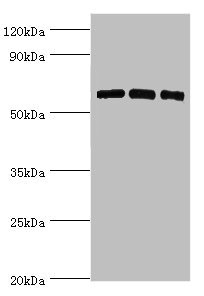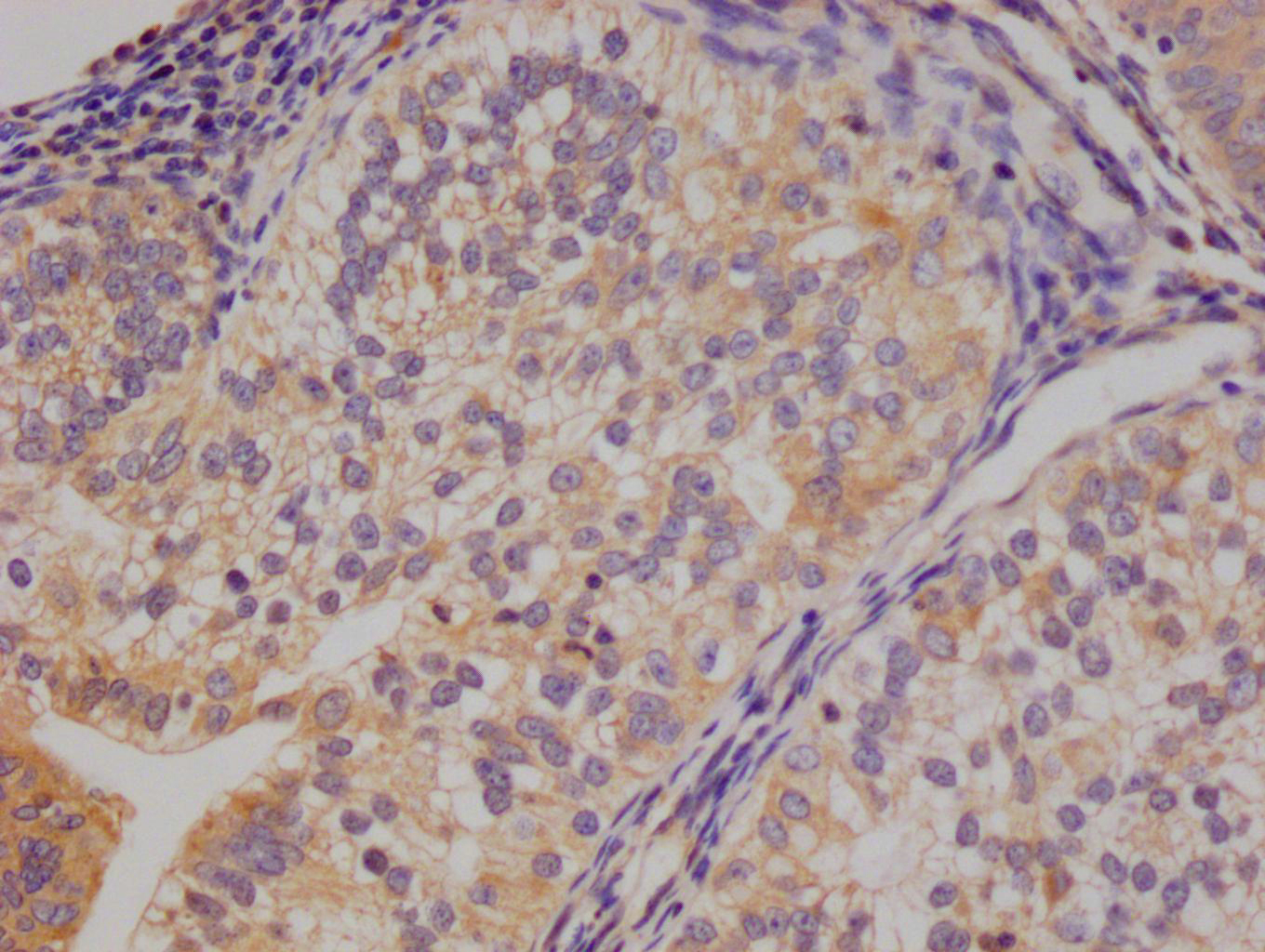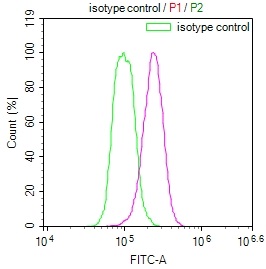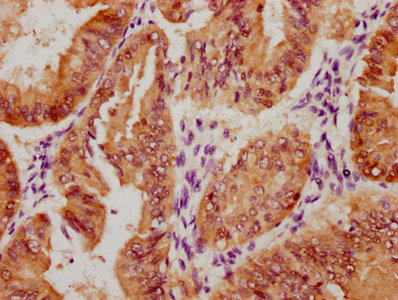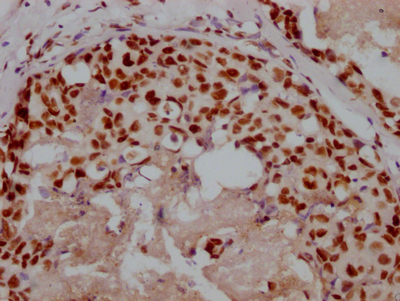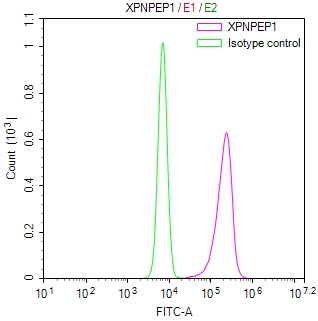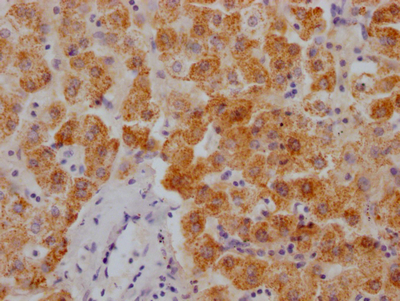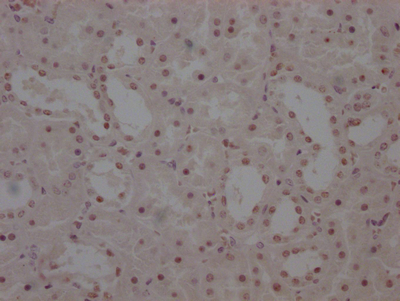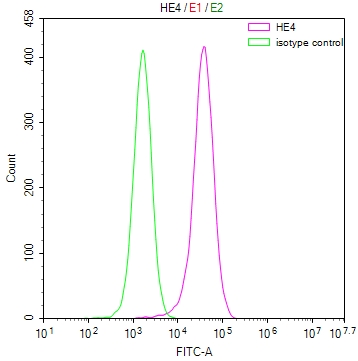PRKAA2 Antibody
-
中文名稱:PRKAA2兔多克隆抗體
-
貨號:CSB-PA805325ESR1HU
-
規格:¥440
-
圖片:
-
其他:
產品詳情
-
產品名稱:Rabbit anti-Homo sapiens (Human) PRKAA2 Polyclonal antibody
-
Uniprot No.:
-
基因名:
-
別名:5'-AMP-activated protein kinase catalytic subunit alpha-2 antibody; AAPK2_HUMAN antibody; ACACA kinase antibody; Acetyl CoA carboxylase kinase antibody; Acetyl-CoA carboxylase kinase antibody; AMPK alpha 2 chain antibody; AMPK subunit alpha-2 antibody; AMPK2 antibody; AMPKa2 antibody; AMPKalpha2 antibody; HMGCR kinase antibody; Hydroxymethylglutaryl CoA reductase kinase antibody; Hydroxymethylglutaryl-CoA reductase kinase antibody; PRKAA antibody; PRKAA2 antibody; Protein kinase AMP activated alpha 2 catalytic subunit antibody; Protein kinase AMP activated catalytic subunit alpha 2 antibody
-
宿主:Rabbit
-
反應種屬:Human
-
免疫原:Recombinant Human 5\'-AMP-activated protein kinase catalytic subunit alpha-2 protein (343-552AA)
-
免疫原種屬:Homo sapiens (Human)
-
標記方式:Non-conjugated
-
克隆類型:Polyclonal
-
抗體亞型:IgG
-
純化方式:Antigen Affinity Purified
-
濃度:It differs from different batches. Please contact us to confirm it.
-
保存緩沖液:PBS with 0.02% sodium azide, 50% glycerol, pH7.3.
-
產品提供形式:Liquid
-
應用范圍:ELISA, WB
-
推薦稀釋比:
Application Recommended Dilution WB 1:500-1:2000 -
Protocols:
-
儲存條件:Upon receipt, store at -20°C or -80°C. Avoid repeated freeze.
-
貨期:Basically, we can dispatch the products out in 1-3 working days after receiving your orders. Delivery time maybe differs from different purchasing way or location, please kindly consult your local distributors for specific delivery time.
-
用途:For Research Use Only. Not for use in diagnostic or therapeutic procedures.
相關產品
靶點詳情
-
功能:Catalytic subunit of AMP-activated protein kinase (AMPK), an energy sensor protein kinase that plays a key role in regulating cellular energy metabolism. In response to reduction of intracellular ATP levels, AMPK activates energy-producing pathways and inhibits energy-consuming processes: inhibits protein, carbohydrate and lipid biosynthesis, as well as cell growth and proliferation. AMPK acts via direct phosphorylation of metabolic enzymes, and by longer-term effects via phosphorylation of transcription regulators. Also acts as a regulator of cellular polarity by remodeling the actin cytoskeleton; probably by indirectly activating myosin. Regulates lipid synthesis by phosphorylating and inactivating lipid metabolic enzymes such as ACACA, ACACB, GYS1, HMGCR and LIPE; regulates fatty acid and cholesterol synthesis by phosphorylating acetyl-CoA carboxylase (ACACA and ACACB) and hormone-sensitive lipase (LIPE) enzymes, respectively. Regulates insulin-signaling and glycolysis by phosphorylating IRS1, PFKFB2 and PFKFB3. Involved in insulin receptor/INSR internalization. AMPK stimulates glucose uptake in muscle by increasing the translocation of the glucose transporter SLC2A4/GLUT4 to the plasma membrane, possibly by mediating phosphorylation of TBC1D4/AS160. Regulates transcription and chromatin structure by phosphorylating transcription regulators involved in energy metabolism such as CRTC2/TORC2, FOXO3, histone H2B, HDAC5, MEF2C, MLXIPL/ChREBP, EP300, HNF4A, p53/TP53, SREBF1, SREBF2 and PPARGC1A. Acts as a key regulator of glucose homeostasis in liver by phosphorylating CRTC2/TORC2, leading to CRTC2/TORC2 sequestration in the cytoplasm. In response to stress, phosphorylates 'Ser-36' of histone H2B (H2BS36ph), leading to promote transcription. Acts as a key regulator of cell growth and proliferation by phosphorylating TSC2, RPTOR and ATG1/ULK1: in response to nutrient limitation, negatively regulates the mTORC1 complex by phosphorylating RPTOR component of the mTORC1 complex and by phosphorylating and activating TSC2. In response to nutrient limitation, promotes autophagy by phosphorylating and activating ATG1/ULK1. In that process also activates WDR45. AMPK also acts as a regulator of circadian rhythm by mediating phosphorylation of CRY1, leading to destabilize it. May regulate the Wnt signaling pathway by phosphorylating CTNNB1, leading to stabilize it. Also phosphorylates CFTR, EEF2K, KLC1, NOS3 and SLC12A1. Plays an important role in the differential regulation of pro-autophagy (composed of PIK3C3, BECN1, PIK3R4 and UVRAG or ATG14) and non-autophagy (composed of PIK3C3, BECN1 and PIK3R4) complexes, in response to glucose starvation. Can inhibit the non-autophagy complex by phosphorylating PIK3C3 and can activate the pro-autophagy complex by phosphorylating BECN1.
-
基因功能參考文獻:
- PRKAA2 Polymorphisms in rs10789038 and rs2796498 are associated with the susceptibility to type 2 diabetes mellitus and diabetic nephropathy. PMID: 28322508
- AMPK phosphorylates DNMT1, RBBP7, and HAT1 and increases interactions of DNMT1, RBBP7, and HAT1. PMID: 28143904
- PGC-1alpha protein was higher after HIHVT than after SIT (p < 0.05). Moreover, the AMPKpTHR172/AMPK ratio increased at post after SIT (p < 0.05), whereas this effect was delayed after HIHVT as it increased after 3 h PMID: 28973039
- TNF-alpha treatment of colonic rho(0) cells augmented IL-8 expression by 9-fold (P < 0.01) via NF-kappaB compared to TNF-alpha-treated control. Moreover, reduced mitochondrial function facilitated TNF-alpha-mediated NF-kappaB luciferase promoter activity as a result of lowered inhibitory IkappaBalpha (nuclear factor of kappa light polypeptide gene enhancer in B-cell inhibitor, alpha), leading to elevated NF-kappaB. ... PMID: 28183804
- Results highlight the contribution of AMPKalpha2 as a mechanism for controlling bladder cancer growth by regulating proliferation through mTOR suppression and induction of p27 protein levels, thus indicating how AMPKalpha2 loss may contribute to tumorigenesis. PMID: 27638620
- AMPK phosphorylation of cortactin followed by SIRT1 deacetylation modulates the interaction of cortactin and cortical-actin in response to shear stress. Functionally, this AMPK/SIRT1 coregulated cortactin-F-actin dynamics is required for endothelial nitric oxide synthase subcellular translocation/activation and is atheroprotective. PMID: 27758765
- inactivation of AMPKalpha2, but not AMPKalpha1, abrogates the tumor attenuation caused by UBE2O loss. PMID: 28162974
- Our findings demonstrate that the AMPKalpha2 catalytic subunit in Kiss1 cells is dispensable for body weight and reproductive function in mice but is necessary for the reproductive adaptations to conditions of acute metabolic distress. PMID: 27732087
- Binding of miR-27a to the 3'-UTR of the AMPKalpha2 gene was required to increase the sensitivity of breast cancer cells to metformin. PMID: 27779715
- p-AMPKalpha was associated with cervical carcinogenesis, and high expression of AMPKalpha2 was correlated with better disease-free survival in patients with early-stage cervical cancer PMID: 26337566
- AMPK-alpha-2 binds to ER-alpha, as well as ER-beta. PMID: 26374855
- Data show that activated AMP-activated protein kinase (AMPK) limits retinal pigment epithelial cells (RPE) phagocytic activity by abolishing retinal photoreceptor cell outer segment (POS)-induced activation of c-mer proto-oncogene tyrosine kinase (MerTK). PMID: 26427488
- AMPKalpha signalling suppresses EMT and secretion of chemokines in renal tubular epithelia through interaction with CK2beta to attenuate renal injury. PMID: 26108355
- A subunit composition of AMPK (alpha2beta2gamma1) is preferred for colorectal cancer cell survival, at least in part, by stabilizing the tumor-specific expression of PGC1B. PMID: 26351140
- CaMKKbeta-AMPKalpha2 signaling contributes to mitotic Golgi fragmentation and the G2/M transition in mammalian cells. PMID: 25590814
- The basal level of ERK phosphorylation was suppressed in cells treated with siRNA against PRKAA2 (AMPK-knockdown cells). PMID: 25846811
- AMPK-alpha co-immunoprecipitates with insulin receptor(IR). The compartmentalization of AMPK-alpha between plasma membrane and Golgi/endosomes fractions in rat's liver is insulin-dependent. Insulin receptor internalization was markedly decreased after AMPK-alpha2 knockdown, and treatment with the ATIC substrate AICAR, which is an allosteric activator of AMPK, increased IR endocytosis in human cultured cells and rat liver. PMID: 25687571
- AMPKalpha2 is an essential mediator of nicotine-induced whole-body IR in spite of reductions in adiposity PMID: 25799226
- High PRKAA2 expression is associated with follicular lymphoma. PMID: 23396962
- AMPKalpha2 suppresses endothelial ACE expression via phosphorylation of p53 and upregulation of microRNA-143/145. PMID: 23476055
- WWP1 down-regulates AMPKalpha2 under high glucose culture conditions via the ubiquitin-proteasome pathway PMID: 23293026
- underexpression of AMPK is frequently observed in HCC, and that inactivation of AMPK promotes hepatocarcinogenesis by destabilizing p53 in a SIRT1-dependent manner. PMID: 22728651
- The results of this study demonistrated that the novel findings that intronic SNPs in the genes coding for the catalytic alpha2 (PRKAA2) of AMPK are associated with antipsychotic-induced weight gain in schizophrenia or schizoaffective disorder patients PMID: 22305490
- The AMPK coordinates nutrient status with mitosis completion, which may be critical for the organism's response to low nutrients during development, or in adult stem and cancer cells. PMID: 22137581
- AMP activated protein kinase-alpha2 regulates expression of estrogen-related receptor-alpha, a metabolic transcription factor related to heart failure development. PMID: 21825219
- IKK is a direct substrate of AMPKalpha2 PMID: 21673972
- The crystal structure of the phosphorylated-state mimic T172D mutant kinase domain from the human AMPK alpha2 subunit is reported in the apo form and in complex with a selective inhibitor, compound C. PMID: 21543851
- AMPKalpha2-by affecting Fyn phosphorylation and activity-plays a key role in platelet alphaIIbbeta3 integrin signaling, leading to clot retraction and thrombus stability PMID: 20558612
- AMPK activates transcription by direct association with chromatin and phosphorylation of histone H2B at ser36; results place AMPK-dependent H2B Ser36 phosphorylation in direct transcriptional and chromatin regulatory pathway leading to stress adaptation PMID: 20647423
- Purification and characterization of truncated human AMPK alpha 2 beta 2 gamma 3 heterotrimer from baculovirus-infected insect cells PMID: 19836452
- AMPKalpha2 functions as a physiological suppressor of NAD(P)H oxidase, ROS production and 26S proteasome activity in endothelial cells. PMID: 20167927
- AMPK functions as a physiological suppressor of endoplasmic reticulum stress by maintaining SERCA activity and intracellular Ca2+ homeostasis. PMID: 20124121
- Hepatic amino acid-dependent signaling is under the control of AMP-dependent protein kinase. PMID: 12067722
- AMPK signaling is not a key regulatory system of muscle substrate combustion during prolonged exercise and marked activation of AMPK via phosphorylation is not sufficient to maintain an elevated ACCbeta Ser(221) phosphorylation during prolonged exercise PMID: 12413941
- Regulation of channel gating by AMP-activated protein kinase modulates cystic fibrosis transmembrane conductance regulator activity in lung submucosal cells. PMID: 12427743
- Overexpression of mutant AMPK-alpha1 enhanced forskolin-stimulated I short-circuit currents, consistent with dominant-negative reduction in inhibition of CFTR by endogenous AMPK. PMID: 12519745
- results suggest that nuclear translocation of 5' AMP-activated protein kinase might mediate the effects of exercise on skeletal muscle gene and protein expression PMID: 12663462
- endothelial AMPK signaling may be a critical determinant of blood vessel recruitment to tissues that are subjected to ischemic stress. PMID: 12788940
- LKB1 kinase, which is associated with Peutz-Jeghers cancer-susceptibility syndrome, phosphorylates and activates AMPK in vitro. PMID: 12847291
- Acetyl-CoA carboxylase beta phosphorylation is especially sensitive to exercise and tightly coupled to AMPK signaling and that AMPK activation does not depend on AMPK kinase activation during exercise. PMID: 12941758
- This study demonstrates that protein content and basal AMPK activity in human skeletal muscle are highly susceptible to endurance exercise training. PMID: 14613924
- AMPK and eEF2 kinase may provide a key link between cellular energy status and the inhibition of protein synthesis, a major consumer of metabolic energy PMID: 14709557
- AMPK is a major regulator of skeletal muscle HSL activity that can override beta-adrenergic stimulation PMID: 15231718
- AMPK is a novel and critical component of HIF-1 regulation, implying its involvement in vanadate-induced prostate carcinogenesis PMID: 15297373
- Results indicate that AMP-activated protein kinase (AMPK)alpha negatively regulates acetyl-CoA carboxylase activity and hepatic lipid content. PMID: 15371448
- AMPK has a role in the phenobarbital induction of CYP2B gene expression PMID: 15572372
- There is a significant basal activity and phosphorylation of AMPK in LKB1-deficient cells that can be stimulated by Ca2+ ionophores, and studies using the CaMKK inhibitor STO-609 and isoform-specific siRNAs show that CaMKKbeta is required for this effect PMID: 16054095
- Overexpression of CaMKKbeta in mammalian cells increases AMPK activity, whereas pharmacological inhibition of CaMKK, or downregulation of CaMKKbeta using RNA interference, almost completely abolishes AMPK activation PMID: 16054096
- causes inappropriate AMP kinase activation, which leads to glycogen accumulation and heart conduction system disease when transfected into mice PMID: 16275868
- data suggest that moderate endurance exercise promotes glucose transport, GLUT4 expression, and insulin sensitivity in skeletal muscle at least partially via activation of the alpha2 isoform of AMPK PMID: 16483872
顯示更多
收起更多
-
亞細胞定位:Cytoplasm. Nucleus. Note=In response to stress, recruited by p53/TP53 to specific promoters.
-
蛋白家族:Protein kinase superfamily, CAMK Ser/Thr protein kinase family, SNF1 subfamily
-
數據庫鏈接:
Most popular with customers
-
-
YWHAB Recombinant Monoclonal Antibody
Applications: ELISA, WB, IHC, IF, FC
Species Reactivity: Human, Mouse, Rat
-
Phospho-YAP1 (S127) Recombinant Monoclonal Antibody
Applications: ELISA, WB, IHC
Species Reactivity: Human
-
-
-
-
-

